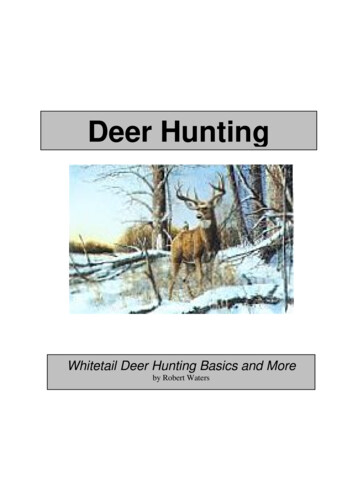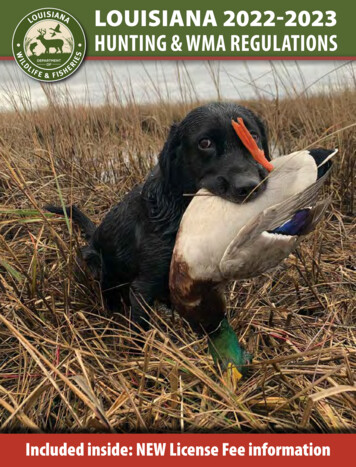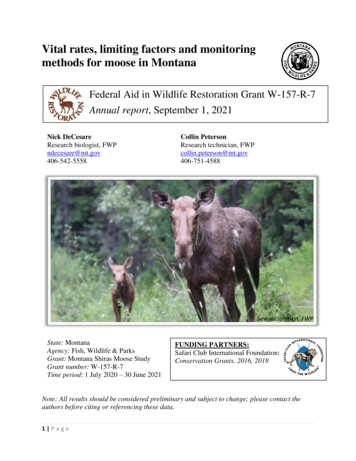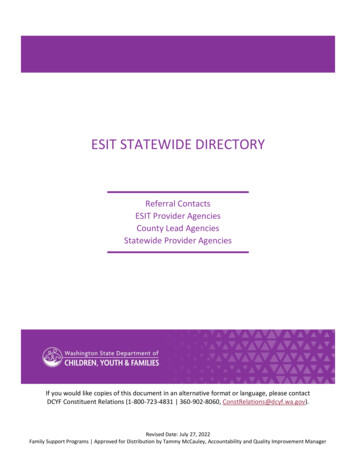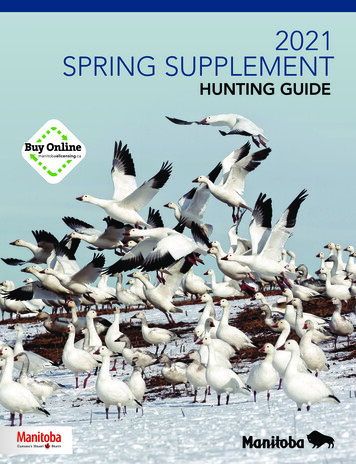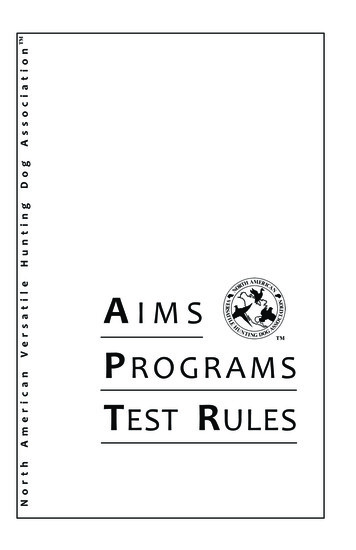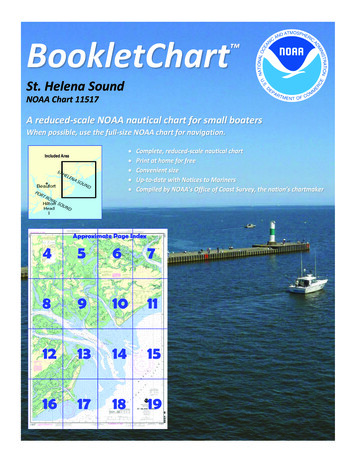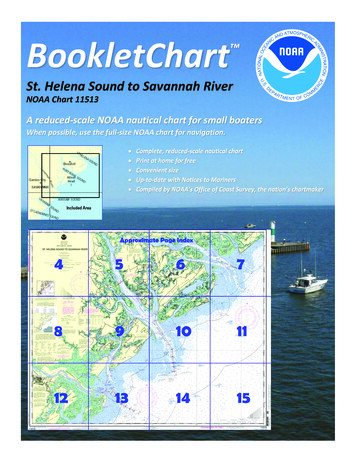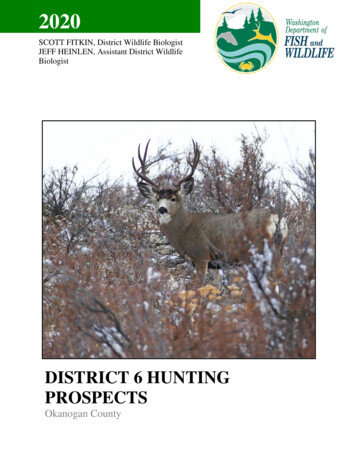
Transcription
2020SCOTT FITKIN, District Wildlife BiologistJEFF HEINLEN, Assistant District WildlifeBiologistDISTRICT 6 HUNTINGPROSPECTSOkanogan County
TABLE OF CONTENTSFIRE AND ROAD CONDITIONS UPDATE .1DISTRICT 6 GENERAL OVERVIEW .1ELK .3General Information, Management Goals, and Population Status .3Which GMU Should Elk Hunters Hunt? .4DEER.4General Information, Management Goals, and Population Status .4Which GMU Should Deer Hunters Hunt? .5What to Expect During the 2020 Season .7How to Find and Hunt Mule Deer .7How to Find and Hunt White-tailed Deer .9Deer Areas . 10BLACK BEAR . 10General Information, Management Goals, and Population Status . 10Which GMU Should bear Hunters Hunt? . 11What to Expect During the 2020 Season . 12COUGAR . 12General Information, Management Goals, and Population Status . 12Which GMU Should Cougar Hunters Hunt? . 12WATERFOWL. 13General Information . 13FOREST GROUSE . 14Species and General Habitat Characteristics. 14Harvest Trends and 2020 Prospects . 15PHEASANTS . 15Species and General Habitat Characteristics. 15
QUAIL. 16Species and General Habitat Characteristics. 16TURKEYS . 17General Description . 17CHUKAR AND GRAY PARTRIDGE . 17General Description . 17DOVE . 18General Description . 18All photos by Scott Fitkin unless otherwise noted.
FIRE AND ROAD CONDITIONS UPDATEAs of mid-July, no major fires are burning in District 6. In addition, most U.S. Forest Service(USFS) roads are open and access has been restored to the Thirty-mile trailhead at the end ofthe Chewuch River Rd. Some long-time washouts remain on scattered secondary roads onthe Methow Ranger District.As always, check with the Okanogan-Wenatchee National Forest for current information onfire activity, access closures, and campfire restrictions.For more information, see: Okanogan National Forest, Methow Valley Ranger DistrictDNR Regulated Fire RestrictionsInciWeb Current Fire StatusOkanogan County Emergency ManagementDISTRICT 6 GENERAL OVERVIEWDistrict 6 is located along the Canadian border in north-central Washington and encompasses 10game management units: 203 (Pasayten), 204 (Okanogan East), 209 (Wannacut), 215(Sinlahekin), 218 (Chewuch), 224 (Perrygin), 231 (Gardner), 233 (Pogue), 239 (Chiliwist), and242 (Alta).The western two-thirds of the district, stretching from the Okanogan River to the Pacific Crest,lies on the east slope of the Cascade Range and is dominated by mountainous terrain that getsmore rugged as you move from east to west. Vegetation in this portion of the district ranges fromdesert/shrubsteppe at the lowest elevations to various types of conifer forests, culminating inalpine tundra on the higher peaks, which top out at almost 9,000 feet. More than three-quarters ofthe land base in this portion of the county is in public ownership, offering extensive huntingaccess. Game is plentiful and dispersed throughout the area for most of the year, concentrating inthe lower elevations in winter when deep snows cover much of the landscape.GMU 204 includes the eastern third of the district (from the Okanogan River east to theOkanogan County line) and features moderately rolling terrain, generally rising in elevation asyou move east. The vegetation changes from shrubsteppe near the Okanogan River to a mix oftall grass and conifer forest throughout the remainder of the unit. This portion of the district isroughly a 50/50 patchwork of public and private land, with the public lands generally beinghigher in elevation. Again, game is plentiful and dispersed throughout.Weather in the Okanogan District can be quite variable and capable of changing quickly in thefall. Be prepared for everything from warm, sunny days to the possibility of winter temperaturesand significant snow at higher elevations by the second week of October.Please be respectful of private land and treat landowners and their property the way youwould want to be treated if roles were reversed.1 P a g e
From top: Methow Wildlife Area and Pasayten WildernessAgency biologists may run a biological check and information station at the Red Barn inWinthrop both weekends of the modern firearm general deer season. We encourage hunters tostop and provide data to biologists whether they have harvested a deer or not. The data we collecthelps us assess herd health and shape population management. Efforts may be constrained byCOVID restrictions.2 P a g e
ELKGENERAL INFORMATION, MANAGEMENT GOALS, AND POPULATIONSTATUSOverall, elk numbers are low in District 6. However, conditions vary noticeably between the eastand west portions of Okanogan County. The western two-thirds of the district are not currentlycovered under a WDFW elk herd management plan, and the existing harvest strategy (any elkgeneral season) is designed to minimize elk numbers to prevent agricultural damage. As such,elk are quite scarce west of the Okanogan River very difficult to find without extensive localknowledge.The eastern portion of the district (GMU 204) is covered by the Selkirk Elk Herd Plan. Its fourprimary goals are:1. To preserve, protect, perpetuate, manage, and enhance elk and their habitats to ensurehealthy, productive populations and ecosystem integrity;2. To manage this elk herd for a sustained hunting yield;3. To manage elk for a variety of recreational, educational, and aesthetic purposes,including hunting, scientific study, cultural and ceremonial uses by Native Americans,biodiversity, wildlife viewing, and photography; and4. To manage elk and elk habitat to minimize human conflicts and agricultural damage.More specifically, GMU 204 supports part of the Pend Oreille sub-herd population, where thecurrent management objective is to gradually increase elk numbers while addressing the abovefour goals. As a result, this unit is now managed with any bull harvest during general modernfirearm and muzzleloader seasons. Elk are not currently abundant enough to warrant a surveyeffort in District 6, but observations suggest numbers continue to increase in GMU 204 andimprove harvest opportunity accordingly. Even so, harvest remains modest with only 18 animalstaken in 2019.For specific harvest information see the District 6 General Season Elk Harvest - 2019.3 P a g e
Bull elkWHICH GMU SHOULD ELK HUNTERS HUNT?As noted above, GMU 204 is the only GMU in District 6 with a significant number of elk.Within this unit, elk tend to be most numerous in the area from Havillah north through theMolson and the Chesaw Wildlife Area, the Waconda Summit / Mount Annie area, and USFSlands bordering the Colville Reservation. In the rest of the district, finding animals is extremelydifficult unless you have up-to-date knowledge on one of the few small bands of elk that waxand wane in the western portion of the county.DEERGENERAL INFORMATION, MANAGEMENT GOALS, AND POPULATIONSTATUSDistrict 6 supports perhaps the largest migratory mule deer herd in the state, and OkanoganCounty has long been prized by hunters for its mule deer hunting opportunity. The district alsosupports significant numbers of white-tailed deer, particularly in GMUs 204 and 215. TheDistrict 6 deer management objective is for stable to modestly increasing populations within thesocial tolerance limits for nuisance and damage issues.4 P a g e
Okanogan District mule deer buckIncreasing post-season fawn:doe ratios and higher than average over-winter fawn survivorshipdocumented in surveys from the past two years indicate that deer numbers are beginning torebound in District 6 in the wake of the extreme fires, severe droughts, and modestly toughwinters from the middle part of the last decade. As previously burned winter range continues torecover and mature, this trend is expected to continue.WHICH GMU SHOULD DEER HUNTERS HUNT?All units in District 6 support significant numbers of deer, include large blocks of accessiblepublic land and offer good to excellent deer hunting opportunity. Mule deer are abundantthroughout the county, with the highest densities in the western two-thirds of the district.Overall, white-tailed deer are less numerous than mule deer in Okanogan County, and in contrastto mule deer, white-tailed deer abundance generally increases as you move east in the district.The largest population is in GMU 204, where white-tailed deer comprise about half of the overalldeer population. Although white-tailed deer numbers are less abundant in the western portion ofthe district, they are still found in most all drainages up to mid-elevations, particularly those withsignificant riparian vegetation. The highest concentrations in this area are in the SinlahekinValley and surrounding drainages. In many areas west of GMU 204 and outside of theSinlahekin Wildlife Area, white-tailed deer frequent private lands. Prospective hunters wishing5 P a g e
to target white-tailed deer may want to seek permission in advance of the season to accessindividual ownerships.Hunters harvested 2,076 (1,853 bucks, 223 antlerless) deer in District 6 during the 2019 generalseasons. This total is up about 11%over last year, but below the five-year average of 2,447.General season success rates rose noticeably for modern firearm hunters but dropped slightly forother weapon types. All remained below their respective five-year averages and broke out asfollows: Modern – 17 %, Muzzleloader – 21 % Archery – 25 %, and Multiple – 28 %.40.0%35.0%30.0%25.0%Archery20.0%Modern FirearmsMultiple 18224231233239242Figure 1. District 6 2019 general season hunter success by weapon type and GMU5-Yr Avg Success by GMU40.00%35.00%% 1233239242GMUFigure 2. District 6 5-year average general season hunter success by weapon type and GMU6 P a g e
As expected, GMU 204 (the district’s largest unit) yielded the greatest overall general seasonharvest of 652 animals. In the western portion of District 6, GMU 215 produced the most harvestwith 275 deer.For specific harvest information see: District 6 2019 General Season Deer HarvestDistrict 6 2019 Special Permit HarvestWHAT TO EXPECT DURING THE 2020 SEASONImproving post-season fawn:doe ratios and higher than average estimated fawn recruitment overthe last two years likely means a modest increase in 2.5-year-old buck availability in 2020.Similarly, the 2019 postseason buck:doe ratio rose to 22 bucks per 100 does, and with about athird of those being greater than or equal to three points, older age-class buck availability looksdecent as well. Overall, total general season harvest and success rates are anticipated to increasesomewhat over the 2019 numbers and be somewhere around the five-year average. This is due inlarge part to the dates for this year’s general season being the latest in the seven-year cycle.Opportunities for older age class bucks during the late permit seasons look good also.The first half of the summer has been cool, but somewhat dry; however, temperatures havesoared in recent weeks and precipitation has been scarce. As a result, deer are likely to be a bitmore concentrated at higher elevations in areas that retain green forage into the early fall. Thelast few days of the general season could see significant numbers of deer beginning to migrate towinter range, particularly if we get significant October snow in the high country.HOW TO FIND AND HUNT MULE DEERDuring the early general seasons, deer will generally be widely distributed on the landscape andnot yet concentrated in migration areas or on the winter range. Mature bucks are often at highelevations in remote locations if succulent vegetation is available. In general, older, higherelevation burns, including the Tripod, Thirty-mile, Farewell, and Needles Fires, are producinghigh-quality summer forage and are a good bet for significant deer activity. Although mule deerwill use a variety of habitat types, they will often forage well into open environments,particularly at dawn and dusk. As a result, they can often be glassed and stalked from aconsiderable distance.During the high hunt, deer will still be spread across the landscape and are found in goodnumbers throughout the Pasayten Wilderness. Easier access to the higher, more open country forhunters on foot is located at the Harts Pass and Iron Gate trailheads at the western and easternends of the wilderness respectively. For those with horses, the Andrews Creek and Billy Goattrailheads offer access to good deer terrain further in. The 30-Mile trailhead is accessible again.For Youth, Senior, and Disabled Hunters holding antlerless tags, does are spread throughout thedistrict during the general season, so permit holders should be able to find antlerless animalsanywhere they have legal access.During the late permit seasons, most deer will have moved to winter range areas at lowerelevations, often on more southerly slopes, to participate in the breeding season. In District 6,WDFW wildlife areas and immediately adjacent federal lands are good bets for high deernumbers in late fall, although in low-snow years, some mature bucks may linger at higher7 P a g e
elevations. In exceptionally mild years, hunters may have to go a bit higher than usual to finddeer concentrations. Some GMU-specific recommendations for late mule deer permit holders areas follows:GMU 215: Look for deer on the south-facing slopes in the Toats Coulee drainage, open portionsof the Sinlahekin Wildlife Area (SWA), and south-facing slopes of the major drainages to thewest of the Sinlahekin, including Cecil, Sarsapkin, and Sinalhekin creeks and their tributaries.GMU 218: The Rendezvous Unit of the Methow Wildlife Area (MWA), and the Cub Creek,Buck Lake, and Lower Boulder Creek area of the Okanogan National Forest (ONF) are goodbets.GMU 224: Favorite spots are portions of the MWA and adjacent ONF lands in the southernportion of the unit. This includes more open habitat in drainages such as Pearrygin, Ramsay,Bear, Blue Buck, Beaver, and Frazier creeks.GMU 231: Check out the Big Buck portion of the MWA, as well as the Virginia Ridge,Thompson Ridge, and Little Bridge Creek areas of the ONF.GMU 233: The main unit and Pogue Mountain Unit of the Scotch Creek Wildlife Area (SCWA),the Carter Mountain Unit of the SWA, and public land in the Salmon Creek Drainage are goodplaces to start.GMU 239: The Texas Creek Unit of the MWA and the Chiliwist Unit of the SWA along withthe adjacent Department of Natural Resources (DNR) land offer good opportunities. Upperportions of Finley, Benson, and Texas creeks on the ONF are also worth a look.GMU 242: Look for deer on the Golden Doe Unit of the MWA and south-facing slopes onpublic land in the Libby Creek and Gold Creek drainages.8 P a g e
Okanogan District white-tailed deer buckHOW TO FIND AND HUNT WHITE-TAILED DEERWhite-tailed deer are typically migrate less than mule deer and generally favor brushier countrywith denser cover at lower and middle elevations. Look for white-tailed deer along streamdrainages and in other areas with riparian vegetation or thick cover. Like mule deer, white-taileddeer are most active at dawn and dusk but often won’t venture as far into larger openings unlessunder the cover of darkness. Look for white-tailed deer in edge habitats where denser coverabruptly transitions into more open meadows. Many white-tailed deer hunters will wait patientlyat a stationary position along an obvious game trail or the forest edge, often employing the use ofa blind or tree stand.During the late permit season, some white-tailed deer summering at modestly high elevationswill move a little way downslope, but most will be in the same areas they inhabited duringsummer. GMU-specific recommendations for late permit holders and late archery season in thewestern portion of the district are as follows:GMU 215: White-tailed deer are abundant on the SWA and Chopaka Unit of the SCWA.GMU 218: Look for deer in the Eight-mile drainage, along the Chewuch River, and in the lowerhalf of the Rendezvous Unit of the MWA (despite the open habitat).9 P a g e
GMU 224: Brushier areas along Bear Creek, Upper Beaver Creek and its tributaries, and basindrained by the West Fork Salmon Creek west of Conconully are good bets.GMU 231: Good possibilities include the huntable portion of the Big Valley Unit of the MWA,and the portion of the unit in the Twisp River Valley (north of the Twisp River Road). Whitetailed deer can sometimes be encountered on the south slopes of the Big Buck Unit of the MWAas they move uphill off private land.GMU 233: Despite the open terrain, the Happy Hill area of the SCWA is productive, along withthe Buzzard Lake Unit of the SWA and adjacent DNR lands.GMU 239: White-tailed deer can be found on ONF land in the South Summit area between LoupLoup Pass and Leecher Mountain and in wetter areas in the western portion of the Chiliwist Unitof the SWA and adjacent DNR lands.GMU 242: Productive areas include the brushy areas along the river and in the northern half ofthe Golden Doe Unit of the MWA, as well as the valley bottom of the Twisp River drainage.Public land along Libby and Gold creeks is also a possibility.Antlerless white-tailed deer permit holders should look for animals in the same areas mentionedabove with the added expectation of a few more deer in the higher reaches of areas like theTwisp River and Eight-mile drainages than might be expected during the late season.DEER AREASFor those hunters with second deer permits in Deer Areas 2012 - 2016, remember that thosepermits are good only on private land. Permit holders are responsible for contacting privatelandowners to secure hunting access.BLACK BEARGENERAL INFORMATION, MANAGEMENT GOALS, AND POPULATIONSTATUSBlack bears are abundant and well-distributed throughout District 6 and are managed forsustainable harvest and diverse age structure. Monitored demographic parameters suggest thelocal population and associated harvest appeared to be relatively stable thru 2018. In 2019 thebag limit was raised to two animals in eastern Washington and harvest increased by around 50%in District 6. It is unknown what effect if any this will have on harvest prospects in 2020.For hunters pursuing black bear in the northern Cascades, it is critical to positively identify thebear species, as endangered grizzly bears potentially also inhabit these areas. WDFW’s websitefeatures some interactive training materials on how to tell the difference between black andgrizzly bears. View the Interactive Bear Identification Program and take the Bear IdentificationTest at WDFW’s website.10 P a g e
WHICH GMU SHOULD BEAR HUNTERS HUNT?All GMUs in the Okanogan District provide good black bear hunting opportunities. In 2019,hunters posted a success rate of 10.4 %and harvested 158 black bears from the western portion ofthe district in Okanogan Bear Management Unit (BMU 5), both of which were significantlyabove the five-year averages. GMU 204 in the Northeastern BMU yielded 44 animals, a littlebelow the five-year average of 51.For specific harvest information see: Okanogan BBMU 2019 Black Bear HarvestNortheastern BBMU 2019 Black Bear HarvestSuccessful Harvest %12.010.08.06.0% re 3. Okanogan District 5-year average black bear harvest success rates by GMUBlack bear11 P a g e
WHAT TO EXPECT DURING THE 2020 SEASONIn general, at the beginning of bear season, animals are likely to be found at middle elevations inareas where berries are peaking. As the season progresses, expect bears to follow the ripeningberries to higher elevations. As we move into fall, animals will range over a wider gradient totake advantage of a variety of late-season food sources. This year, after a late onset for serviceberries, a warm spell accelerated the development of the later crops and timing should be aboutaverage as the bear season arrives. Berry crops look good across most shrub species this year.COUGARGENERAL INFORMATION, MANAGEMENT GOALS, AND POPULATIONSTATUSThe District 6 cougar population is healthy and dispersed throughout the landscape. In theOkanogan District, cougars are managed by a harvest guideline at the scale of one or two GMUsto better promote stable population structure and high-quality sustainable harvest, while alsominimizing human-cougar conflicts.Cougars follow the deer herds, which means they will be spread throughout the district throughlate October and concentrate more at lower elevations as deer move to winter range. Muchcougar foraging activity takes place at night, so the best opportunities to spot the cats on themove are at dawn and dusk.WHICH GMU SHOULD COUGAR HUNTERS HUNT?All Okanogan District GMUs support cougars and are open to hunting. After Jan. 1, individualPMUs (one or more GMUs) close on short notice once the harvest guideline has been reached,and hunters are responsible for knowing if a unit is open or closed. This information is availableon the WDFW hotline (1-866-364-4868) or online.Last season, harvest in District 6 did not exceed the guideline in any PMU, and control-relatedmortality was moderate. As a result, cougar numbers should be robust and hunting opportunitiesin District 6 should be good in 2020-21. See the five-year harvest summary table below.PMU HuntArea(GMUs)203204209, 215218, 30650212010433470431035Table 1. District 6 cougar harvest guidelines and 5-year harvest by GMU12 P a g e
CougarWATERFOWLGENERAL INFORMATIONThe Okanogan District offers modest waterfowl hunting opportunities as compared to manyother areas of the state. The largest concentrations of birds occur at the southern edge of District6, at the mouth of the Okanogan River and on the Columbia River. The main stem of theOkanogan and Upper Similkameen rivers and the larger lakes and potholes in the OkanoganWatershed are good secondary sites. Good public river access is found at the Washburn IslandUnit of the Wells Wildlife Area, the Driscoll-Eyhott Island Unit of the Sinlahekin Wildlife Area,and the Similkameen-Chopaka Unit of the Scotch Creek Wildlife Area.13 P a g e
From top: lesser Scaup pair and Canada geeseWater levels in local potholes fell further following another mild winter and many dried upentirely. River levels are currently running below normal and are likely to be similar going intothe hunting season. Aside from water levels, waterfowl hunting opportunities are mostlydependent on the number of migrants coming from Canada and Alaska, and how long waterremains ice-free throughout the district.For specific harvest information see: Canada Goose Harvest by County,Duck Harvest by CountyFOREST GROUSESPECIES AND GENERAL HABITAT CHARACTERISTICSThe Okanogan supports strong populations of ruffed, dusky (blue), and spruce grouse foundthroughout the forested areas of the district. Ruffed grouse are generally associated withdeciduous tree cover at lower to middle elevations, particularly in riparian habitats. Duringhunting season, dusky (blue) grouse are generally encountered in the mid to upper elevationconifer forests, often moving to ridges as snow begins to accumulate. Spruce grouse are found inhigher elevation conifer forests throughout the district on a year-round basis. Additional tips onhunting forest grouse can be found at Forest grouse hunting tips.Forest grouse populations (particularly dusky and spruce grouse) are likely below historicalnorms within the boundaries of recent large wildfires, including the Carlton Complex, Okanogan14 P a g e
Complex, Tunk Block, and Tripod, Diamond Creek, and Crescent Mountain fires. These firesburned in some of the best and most densely occupied forest grouse habitat in the district.However, grouse habitat within the burns is improving annually (particularly in the Tripod Firearea), and bird numbers outside of burned areas appear to be relatively stable.HARVEST TRENDS AND 2020 PROSPECTSThe sprawling landscape of Okanogan yielded a mixed harvest of dusky, ruffed, and sprucegrouse, very similar to the previous season and from the five-year average.For specific harvest information see: Forest Grouse Harvest by County.From left: female spruce grouse and male ruffed grouse.PHEASANTSSPECIES AND GENERAL HABITAT CHARACTERISTICSPheasants occur at low densities and in a patchy distribution throughout the OkanoganWatershed portion of District 6, with most harvested birds coming from pheasant release sites.This year, pheasants will again be released at the Bureau of Reclamation’s Hegdal and Klinesites, and at the Chilliwist Unit of the Sinlahekin Wildlife Area. What little wild productionexists within the county comes mostly from private land. Hunters should seek permission inadvance of the season to access private property. Additional hunting tips for pheasants can befound at Pheasant hunting tips.15 P a g e
The release sites are mapped in the Eastern Washington Pheasant Release booklet found here:Eastern Washington Pheasant Release Program. Hunters are reminded that nontoxic shot isrequired for all upland bird hunting on all pheasant release sites statewide.Hunters bagged 1,562 pheasants last year in Okanogan County, more than doubling the tallyfrom the previous year. Hunting pressure increased only slightly, suggesting an improvement innatural pheasant reproduction supplementing the release program.For specific harvest information see: Pheasant Harvest by CountyPheasant release – Photo by Jeff HeinlenQUAILSPECIES AND GENERAL HABITAT CHARACTERISTICSQuail are locally abundant and widespread throughout the district’s lower elevation shrubsteppea
covered under a WDFW elk herd management plan, and the existing harvest strategy (any elk general season) is designed to minimize elk numbers to prevent agricultural damage. As such, elk are quite scarce west of the Okanogan River very difficult to find without extensive local knowledge.
